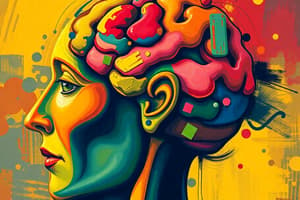Podcast
Questions and Answers
What is the first type of sound that people usually lose their hearing for as they age?
What is the first type of sound that people usually lose their hearing for as they age?
- Low-frequency sounds
- High-frequency sounds (correct)
- All frequencies equally
- Middle-frequency sounds
Which aspect of intelligence increases with age?
Which aspect of intelligence increases with age?
- Inductive reasoning skills
- Short-term memory capacity
- Fluid intelligence
- Crystallized intelligence (correct)
What condition results from chronic stress due to overproduction of corticosteroids?
What condition results from chronic stress due to overproduction of corticosteroids?
- Enhanced immune response
- Increase in white blood cell count
- Decrease in effectiveness of white blood cells (correct)
- Heightened cognitive function
During which stage of cognitive development do adults focus on responsibilities?
During which stage of cognitive development do adults focus on responsibilities?
Which group is at an increased risk for high blood pressure and stroke?
Which group is at an increased risk for high blood pressure and stroke?
What is meant by 'expertise' in the context of cognitive aging?
What is meant by 'expertise' in the context of cognitive aging?
How does fluid intelligence change with age?
How does fluid intelligence change with age?
What did the Seattle Longitudinal Study measure regarding cognitive processes?
What did the Seattle Longitudinal Study measure regarding cognitive processes?
What is the primary focus of generativity in Erikson's theory?
What is the primary focus of generativity in Erikson's theory?
Which of the following is NOT a form of generativity described in Erikson's stages?
Which of the following is NOT a form of generativity described in Erikson's stages?
What is a potential result of stagnation according to Erikson's stages?
What is a potential result of stagnation according to Erikson's stages?
Which factor might influence how individuals experience a midlife crisis?
Which factor might influence how individuals experience a midlife crisis?
What approach posits that crises can arise from major life events?
What approach posits that crises can arise from major life events?
Which of these is NOT considered a mediating variable in the life events approach?
Which of these is NOT considered a mediating variable in the life events approach?
What societal perceptions might exaggerate the concept of a midlife crisis?
What societal perceptions might exaggerate the concept of a midlife crisis?
Daily stressors in middle adulthood may include which of the following?
Daily stressors in middle adulthood may include which of the following?
What is true regarding the personality of individuals in late adulthood?
What is true regarding the personality of individuals in late adulthood?
Which of the following describes a challenge faced during late adulthood?
Which of the following describes a challenge faced during late adulthood?
How is life expectancy defined?
How is life expectancy defined?
Which group is typically characterized as the oldest-old?
Which group is typically characterized as the oldest-old?
What factor primarily determines the functional age of an individual?
What factor primarily determines the functional age of an individual?
What is considered the most widely recognized marker of transitioning to adulthood?
What is considered the most widely recognized marker of transitioning to adulthood?
Which of the following is NOT a key feature of emerging adulthood?
Which of the following is NOT a key feature of emerging adulthood?
What factor has contributed to the increase in age of childbirth since 1970?
What factor has contributed to the increase in age of childbirth since 1970?
What is the primary factor associated with the higher mortality rates observed in early adulthood?
What is the primary factor associated with the higher mortality rates observed in early adulthood?
What role does leptin play in the body regarding weight management?
What role does leptin play in the body regarding weight management?
Which statement about binge drinking among college students is accurate?
Which statement about binge drinking among college students is accurate?
What is one of the characteristics of postformal thought as described by Piaget?
What is one of the characteristics of postformal thought as described by Piaget?
What is the most effective method for losing or maintaining weight in early adulthood?
What is the most effective method for losing or maintaining weight in early adulthood?
What challenge do emerging adults face when transitioning to college?
What challenge do emerging adults face when transitioning to college?
Which of the following factors is most important in determining success in early adulthood?
Which of the following factors is most important in determining success in early adulthood?
What is the primary emotional regulation method that middle-aged adults with better self-control as children demonstrate?
What is the primary emotional regulation method that middle-aged adults with better self-control as children demonstrate?
Which personality factor is associated with higher marital satisfaction and better GPA?
Which personality factor is associated with higher marital satisfaction and better GPA?
What trend is observed in the personality of individuals from age 20 to midlife according to longitudinal studies?
What trend is observed in the personality of individuals from age 20 to midlife according to longitudinal studies?
What impact does the 'Empty Nest Syndrome' typically have on marital satisfaction?
What impact does the 'Empty Nest Syndrome' typically have on marital satisfaction?
Which of the following best represents the 'Squeezed Generation' phenomenon?
Which of the following best represents the 'Squeezed Generation' phenomenon?
What does the trait of 'Neuroticism' correlate with according to personality studies?
What does the trait of 'Neuroticism' correlate with according to personality studies?
Which of the following is NOT one of the Big Five personality factors?
Which of the following is NOT one of the Big Five personality factors?
What may lead to individuals distancing themselves from their partner?
What may lead to individuals distancing themselves from their partner?
What is a common reason cited for delays in divorce among middle-aged adults?
What is a common reason cited for delays in divorce among middle-aged adults?
Which characteristic is typically associated with individuals exhibiting anxious attachment?
Which characteristic is typically associated with individuals exhibiting anxious attachment?
What is an ideal state of love according to Sternberg's Triangle of Love?
What is an ideal state of love according to Sternberg's Triangle of Love?
According to Erikson's theory, what is the primary psychosocial challenge faced during middle adulthood?
According to Erikson's theory, what is the primary psychosocial challenge faced during middle adulthood?
What misconception about parenting suggests that a child will behave like their parents?
What misconception about parenting suggests that a child will behave like their parents?
What effect does the Big Five personality model have on understanding individual differences?
What effect does the Big Five personality model have on understanding individual differences?
In which phase of life do most significant personality changes occur according to studies?
In which phase of life do most significant personality changes occur according to studies?
Which group of divorced individuals is characterized as motivated to find new mates quickly?
Which group of divorced individuals is characterized as motivated to find new mates quickly?
How has the average age of marriage changed over the decades?
How has the average age of marriage changed over the decades?
What ranking do adults typically express related to feelings towards caring for aging parents?
What ranking do adults typically express related to feelings towards caring for aging parents?
What factor is essential for maintaining intimacy according to the content?
What factor is essential for maintaining intimacy according to the content?
The Big Five personality components operate in what manner?
The Big Five personality components operate in what manner?
Which of the following represents a misconception about having children?
Which of the following represents a misconception about having children?
What does the Matching Hypothesis refer to in romantic attraction?
What does the Matching Hypothesis refer to in romantic attraction?
What common pathway for exiting divorce involves becoming more self-fulfilled?
What common pathway for exiting divorce involves becoming more self-fulfilled?
What aspect of gender differences in friendships suggests women tend to engage in?
What aspect of gender differences in friendships suggests women tend to engage in?
What is a characteristic of individuals classified as Competent Loners?
What is a characteristic of individuals classified as Competent Loners?
Which statement accurately describes first impressions based on attractiveness?
Which statement accurately describes first impressions based on attractiveness?
What is a potential effect of the increased age of childbirth?
What is a potential effect of the increased age of childbirth?
Which emotional state is associated with intimacy vs isolation in Erikson's theory?
Which emotional state is associated with intimacy vs isolation in Erikson's theory?
Flashcards
Emerging Adulthood
Emerging Adulthood
The period from ages 18-25, often marked by gaining economic independence and taking responsibility for oneself.
Physical Performance Peak
Physical Performance Peak
Physical abilities usually reach their peak in the early twenties (19-26).
Obesity Trends
Obesity Trends
Obesity rates increased significantly from 2011 to 2020.
Set Point
Set Point
Signup and view all the flashcards
Binge Drinking
Binge Drinking
Signup and view all the flashcards
Formal Operational Thought
Formal Operational Thought
Signup and view all the flashcards
Obesity Environmental Factors
Obesity Environmental Factors
Signup and view all the flashcards
Increased Stress in College
Increased Stress in College
Signup and view all the flashcards
Cognitive Development
Cognitive Development
Signup and view all the flashcards
Postformal Thought
Postformal Thought
Signup and view all the flashcards
Intimacy vs. Isolation
Intimacy vs. Isolation
Signup and view all the flashcards
Intimacy (Erikson)
Intimacy (Erikson)
Signup and view all the flashcards
Isolation (Erikson)
Isolation (Erikson)
Signup and view all the flashcards
Attraction: First Impressions
Attraction: First Impressions
Signup and view all the flashcards
Familiarity/Similarity in Attraction
Familiarity/Similarity in Attraction
Signup and view all the flashcards
Consensual Validation
Consensual Validation
Signup and view all the flashcards
Matching Hypothesis
Matching Hypothesis
Signup and view all the flashcards
Sternberg's Triangular Theory of Love
Sternberg's Triangular Theory of Love
Signup and view all the flashcards
Passion (Sternberg)
Passion (Sternberg)
Signup and view all the flashcards
Intimacy (Sternberg)
Intimacy (Sternberg)
Signup and view all the flashcards
Commitment (Sternberg)
Commitment (Sternberg)
Signup and view all the flashcards
Affectionate Love
Affectionate Love
Signup and view all the flashcards
Consummate Love
Consummate Love
Signup and view all the flashcards
Lower sexual satisfaction
Lower sexual satisfaction
Signup and view all the flashcards
Higher depressive/anxious symptoms
Higher depressive/anxious symptoms
Signup and view all the flashcards
Accommodation Loss
Accommodation Loss
Signup and view all the flashcards
High-Frequency Hearing Loss
High-Frequency Hearing Loss
Signup and view all the flashcards
Chronic Disorder
Chronic Disorder
Signup and view all the flashcards
Cortisol and Stress
Cortisol and Stress
Signup and view all the flashcards
Fluid Intelligence
Fluid Intelligence
Signup and view all the flashcards
Crystallized Intelligence
Crystallized Intelligence
Signup and view all the flashcards
Seattle Longitudinal Study
Seattle Longitudinal Study
Signup and view all the flashcards
Expertise
Expertise
Signup and view all the flashcards
Generativity
Generativity
Signup and view all the flashcards
Stagnation
Stagnation
Signup and view all the flashcards
Midlife Crisis
Midlife Crisis
Signup and view all the flashcards
Life Events Approach
Life Events Approach
Signup and view all the flashcards
Adaptation Process
Adaptation Process
Signup and view all the flashcards
Life-stage Context
Life-stage Context
Signup and view all the flashcards
Sociohistorical Context
Sociohistorical Context
Signup and view all the flashcards
Daily Stressors
Daily Stressors
Signup and view all the flashcards
Functional Age
Functional Age
Signup and view all the flashcards
Late Adulthood Substages
Late Adulthood Substages
Signup and view all the flashcards
Life Span vs. Life Expectancy
Life Span vs. Life Expectancy
Signup and view all the flashcards
Factors Affecting Life Expectancy
Factors Affecting Life Expectancy
Signup and view all the flashcards
Gender Differences in Life Expectancy
Gender Differences in Life Expectancy
Signup and view all the flashcards
Emotional Regulation and Aging
Emotional Regulation and Aging
Signup and view all the flashcards
Gender Differences in Stress Response
Gender Differences in Stress Response
Signup and view all the flashcards
Personality Stability
Personality Stability
Signup and view all the flashcards
Lexical Hypothesis
Lexical Hypothesis
Signup and view all the flashcards
Openness to Experience
Openness to Experience
Signup and view all the flashcards
Conscientiousness
Conscientiousness
Signup and view all the flashcards
Extraversion
Extraversion
Signup and view all the flashcards
Agreeableness
Agreeableness
Signup and view all the flashcards
Neuroticism
Neuroticism
Signup and view all the flashcards
Factor Analysis
Factor Analysis
Signup and view all the flashcards
Personality Stability Over Time
Personality Stability Over Time
Signup and view all the flashcards
Midlife Personality Shifts
Midlife Personality Shifts
Signup and view all the flashcards
Marital Satisfaction in Middle Adulthood
Marital Satisfaction in Middle Adulthood
Signup and view all the flashcards
Empty Nest Syndrome
Empty Nest Syndrome
Signup and view all the flashcards
Generativity vs. Stagnation
Generativity vs. Stagnation
Signup and view all the flashcards
Study Notes
Adulthood
- Emerging adulthood: Ages 18-25, marked by first full-time job, economic independence, and personal responsibility. Other cultures might define adulthood differently.
- Key features of emerging adulthood: Identity exploration, instability (frequent job/living changes), self-focus, feeling in-between, and optimism about the future.
Trends
- Increased age of childbirth since 1970. Increased education and employment before childbirth.
- Typically, depressive symptoms and self-esteem improve, whereas family wealth and hard work remain important indicators of success for young adults.
- Non-normative events (teen pregnancy, etc.) force earlier adulthood.
Physical Development
- Physical performance peaks before age 30.
- Higher mortality rates in early adulthood than during adolescence are linked to unhealthy habits.
- Inactivity, poor diet, and obesity increase substance abuse risks. 27% of adults were obese in 2011; 40% in 2020.
- Obesity associated with health risks, including increased disease risk from unhealthy foods subsidized by government programs.
Cognitive Development
- Adults use formal operational thought, but quantitatively knowledge increases.
- Adults typically increase their knowledge in a specialized area.
- Postformal thought includes reflectivity, relativism, and contextualism.
- Emotions/feelings may cloud judgment and decisions.
Socioemotional Development
- Temperament links to adult personality (easy temperament = better adjusted; more childhood inhibition = less assertive).
- Adult attachment: attachment styles continue from childhood to adult romantic relationships.
- Secure attachment predicted as a positive, close, and unstressed relationship.
- Intimacy vs. Isolation: Young adults struggle with intimacy in relationships and social isolation.
- Gender differences in friendships also exist (women more likely to maintain close friendships and engage in self disclosure; men are more likely to maintain distance in friendships.
Attraction
- First impressions of attractiveness are reliable and made quickly (within 100ms).
- Similarity of attitudes and behaviors are important factors in romantic relationships (consensual validation).
- Physical attractiveness is often important to potential partners.
- Sternberg's triangular theory of love describes love as having three aspects: passion, intimacy, and commitment.
Marriage and Parenting
- Average age of marriage is increasing.
- Parenting is increasingly viewed as a complex issue requiring training, not simply an instinct.
- Challenges to marital relationships: Parenting, finances, or conflict.
Middle Adulthood
- Rectangularization: Population pyramids become more rectangular, reflecting an increase in the proportion of older people due to longer life expectancy.
- Increased stress and depression than previous generations.
- Exercise and weight management are important.
Late Adulthood: Physical Development
- Life expectancy increases over time.
- Physical changes (vision loss, loss of hearing/smell/taste, loss of mobility) require accommodations.
- Chronic diseases become more prevalent.
- Risk of death increases from 75 and older due to chronic diseases like cancer, heart issues, etc.
Late Adulthood: Cognitive Development
- Fluid intelligence (reasoning, abstract thinking) decreases.
- Crystallized intelligence increases (accumulated knowledge and skills).
- Cognitive processing speeds also decrease with age.
- Memory function can change, especially working and episodic memory, but more implicit memory is maintained.
Late Adulthood: Social and Emotional Development
- Integrity vs despair: Reflection on life and evaluating successes.
- Happiness: Activity theory (active older adults are happier); socioemotional selectivity theory (prioritizing relationships); selective optimization with compensation theory (adjusting to age-related decline through selection, optimization, and compensation).
- Dementia diagnoses are common.
Summary
- Adult development is complex, multi-faceted, and influenced by biological, psychological, and environmental factors.
- Development does not end at adulthood and continues to late adulthood.
- There are various changes associated with age, either positive or negative. Each stage has unique challenges and opportunities.
Studying That Suits You
Use AI to generate personalized quizzes and flashcards to suit your learning preferences.
Related Documents
Description
This quiz explores key concepts in the psychology of aging, including cognitive development, intelligence, and Erikson's stages of psychosocial development. Test your knowledge on how aging affects sound perception, fluid intelligence, and the implications of generativity versus stagnation in adulthood.




